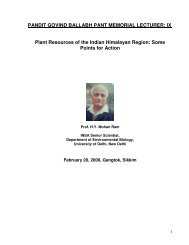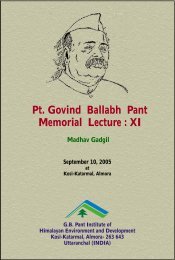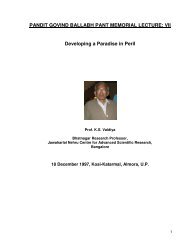Pandit Govind Ballabh Pant Memorial Lecture: II
Pandit Govind Ballabh Pant Memorial Lecture: II
Pandit Govind Ballabh Pant Memorial Lecture: II
Create successful ePaper yourself
Turn your PDF publications into a flip-book with our unique Google optimized e-Paper software.
Similar<br />
Distinct<br />
Distinct<br />
ECOTYPE<br />
(ecological<br />
races)<br />
The same The same<br />
entity<br />
Genetic species only (Example:<br />
autoploidy; certain kinds of<br />
chromosomal repattering<br />
Fig. 11. Relationship between systematics, genetics and ecology<br />
Behind such a common genetic and ecological thread, there are the specific<br />
attributes of genetic diversity, life history traits, population dynamics including its<br />
genetic architecture which equips a species to interact with other species and<br />
environment. Genetic diversity also equips a species at the molecular level to<br />
generate new variation through the processes of mutation, recombination and<br />
natural selection, leading to elimination of some and selection of others. Thus a<br />
phenotype is the result of interaction between genotype and environment. The<br />
phenotypic characteristic of an individual are coded into the genes of a taxon which<br />
determines whether it is going to be miniscule virus or an amoebae, or a giant like<br />
squoia, elephant or a whale. Today’s biodiversity is, therefore, the result of mutation,<br />
recombination and natural selection having taken place during the last 3 billion<br />
years. Life began with a DNA molecule having properties of self-replication, mutation<br />
and recombination. Genetic diversity is, therefore a prerequisite for all biological<br />
evolution leading to diversity (see also Solbrig, 1991). Biodiversity can be reduced<br />
both by habitat destruction leading to failure of populations to recover from mortality<br />
caused by habitat disturbances, and also by competitive exclusion thus there is<br />
interaction between competitive exclusion and mortality due to habitat disturbance.<br />
According to Huston (1991), when these two opposing trends are balanced, there is<br />
maximum biodiversity at intermediate disturbance level.<br />
Intraspecific genetic diversity is the fundamental building block of maintaining<br />
biodiversity. The natural selection acts on this, and populations are refined to<br />
function as interacting units within communities and ecosystems. The genetic<br />
consequence of habitat fragmentation leads to restrictions in gene flow and may be,<br />
in course time, to genetic differentiation. The particular life form of a species is also<br />
the consequence of selection. Thus, there are pine forests in the Himalaya. These<br />
are essentially large populations of big individuals with long life and good seed<br />
dispersal. Such populations have high productivity and live in low habitat<br />
disturbances. Conversely low productivity and high habitat distrubances. Destruction<br />
occurs due to abiotic causes (like extreme climatic conditions, fire, floods, etc) or<br />
biotic causes; (like parasitism, disease, predation, herbivory etc.). These lead to a<br />
competitive advantage for smaller populations, of small individuals with short life<br />
cycles. There are many such correlations (Stebbins, 1950;Grant, 1958, Gadgil and<br />
Solbrig 1972). The measurement of diversity can be at the allelic level within<br />
individuals or species, or at the level of gene pool on a population. This diversity can<br />
be studied through RFLP and RAPD. Next follows species richness in a community<br />
44











